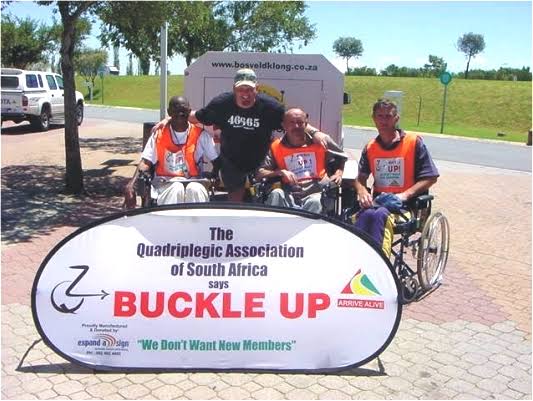Paraplegia
Introduction
Paraplegia is an injury to the spinal cord at the thoracic level & below resulting in an impairment in motor or sensory function of the lower half of the body. This condition occurs due to damage to the cellular structure of the spinal cord within the spinal canal. The area of the spinal cord which is affected in paraplegia is either the thoracic, lumbar, or sacral regions of the spinal column, the person retains full use of their arms & hands, but have poor trunk control & balance due to the lack of abdominal muscle control.
Lower thoracic injuries (T-9 to T-12) retain good truck control & good abdominal muscle control, the sitting balance of people with lower spinal cord injuries is usually very good. Injuries to the Lumbar & sacral injuries result in decreased control of the hip flexors & legs. Although paraplegia occurs below L2, the correct terminology for injury to these lower spinal nerves is called "Cauda Equine Syndrome". If the arms are also affected by paralysis, Quadriplegia/Tetraplegia is the correct terminology.
Mobility Impairments or a physical disability is one that affects a person's mobility or dexterity, it can be the result of an accident, leading to paralysis, loss of limbs or brain damage, or can be genetic, like Spina Bifida, Muscular Dystrophy, or people who are born without limbs. There are a wide variety of different types of physical disabilities that fall under Mobility Impairments, whatever the cause of the disability, persons with disabilities require a different set of emotional and physical needs & may need to use some sort of equipment for assistance with mobility & for them to be able to fully participate in society. There are also various organizations in South Africa that assist & support different disability groups with a wide variety of services. An example of this type of organization is The QuadPara Association of South Africa (QASA), who assists Quadriplegics & Paraplegics living in South Africa.
Whatever the cause of the disability, persons with disabilities require a different set of emotional and physical needs & may need to use some sort of equipment for assistance with mobility & for them to be able to fully participate in society. There are also various organizations in South Africa that assist & support different disability groups with a wide variety of services.
Support Organizations
There are a wide range of these advocacy and self-help organization which exist in South Africa, they include organizations such as the overtly political Disabled People South Africa, aligned with the ruling African National Congress, the National Council of and for Persons with Disabilities (NCPD) and DiSA, as well as single-issue national organizations such as the QuadPara Association of South Africa to name just a few.
The QuadPara Association of South Africa (QASA)
QASA:The QuadPara Association of South Africa (QASA) is a non-profit organisation (NPO 000-881) of Quadriplegics and Paraplegics in South Africa.
QASA’s mission is “to improve lives by securing resources to advocate, educate, capacitate, support and mobilize”. QASA develops products, programmes and services for quadriplegic and paraplegic members to build their capacity and ensure opportunities for societal integration and empowerment. QASA’s vision is that “all quadriplegics and paraplegics will live their lives to their full potential”.
QASA is a member of the South Africa Disability Alliance (SADA) and has significant relationships with other such organisations, such as the Department of Social Development, the Chris Burger Petro Jackson Players Fund and the National Council of and for Persons with Disabilities in South Africa (NCPD).
Four Regional Associations are affiliated to QASA: Gauteng South, Gauteng North, Western Cape and North West. The QASA Management Board is made up of representatives of each Regional Association.
QASA invests in programmes that up skills and supports members who pursue employment opportunities, whether this is through skills development, employment programmes that educate employers on the value proposition of our skilled members, or bursaries for tertiary or continued education.
The organisation supports the health and wellness of its members through educational programmes for members, caregivers, and the healthcare sector. Well-researched information is shared with members and the public sector. QASA provides better mobility, assistive devices, and accessibility for its members to ensure a barrier-free environment. This includes assisting with accessible housing, independent living solutions and even driver training programmes.
QASA also advocates and lobbies on behalf of its members to ensure universal access and inclusion in the built environment and transport nodes. This includes disability awareness and sensitisation workshops, access audits, and the promotion of the White Paper on the Rights of Persons with Disabilities. Prevention of spinal cord injury forms part of our advocacy commitment.
QASA is sustained by strategic relationships with corporates, social enterprise, the National Lottery Commission and a number of campaigns and events. Some of QASA’s projects generate revenue which services the essential non-revenue generating projects.
To support the QuadPara Association of South Africa (QASA), you can contact them on telephonically at 031 767 0352, on e-mail at info@qasa.co.za, or send a letter to P.O. Box 2368, Pinetown, 3600, South Africa. Alternatively visit their website at www.qasa.co.za.
Visit our Organizations - Mobility Impairments page to find out more about The QuadPara Association of South Africa (QASA) and other organizations that assist persons with Mobility Impairments, or read the information below to find out more about the various conditions that can lead to Mobility Impairments.
Awareness Campaigns
QASA Conducts various Awareness Campaigns and prevention programmes which aim to prevent future injuries by simply making the public aware of simplest things, these prevention programmes include the "Diving Prevention Campaign" & "Buckle Up"' - "We Don’t Want New Members". QASA also does awareness talks at school and have a strong relationship with the Chris Burger Petro Jackson Players Fund.
1. Diving Prevention Program: QASA produced a DVD warning of the dangers of diving, which is a major cause of spinal cord injury. This DVD was flighted on eTV and shows the dangers of diving into water without checking the water depth first. QASA also does awareness talks at school.
2. Chris Burger Petro Jackson Players Fund: QASA has a strong relationship with the Chris Burger Petro Jackson Players Fund. The Chris Burger Petro Jackson Players Fund assists all spinal cord injured persons, who have injured themselves playing sport. Furthermore, they promote the wellness of rugby and prevention of spinal cord injury in rugby. Read More: ....
3. Buckle Up: "We Don’t Want New Members": Is a road safety campaign aimed at getting motorists to use their seatbelts. The QuadPara Association of South Africa asks motorists to wear their seat belts in order to prevent a spinal cord injury in the event of an accident! This Road safety initiative is a partnership between the Association and Arrive Alive and the campaign was awarded the S.A.Guild of Motoring Journalists “Road Safety Project of the Year” award. QASA also does awareness talks at school.
The road safety campaign also includes motorcyclists, the Associations members also deploy the “Gear Up – We don’t want new members” campaign which is in partnership with the Steelwings Motorcycle Club who have funded this campaign. The QuadPara Association is adamant that if you are wearing your seatbelt and are in an accident, your chances of sustaining a spinal cord injury is drastically reduced. More than 450 people become spinal cord injured in South Africa and half of these are from road accidents, the impact on their lives and the lives of their families is devastating. QASA are proud to deliver a road safety programme to the public which will not only reduce the number of persons sustaining spinal injuries in accidents, but QASA will employ their members in implementing the project. Some of the very victims of road accidents, will be at the garage sites, encouraging road safety to the public. Motorists are approached at the garages by quadriplegics and paraplegics and asked to sign a pledge to Buckle Up, and in return they will receive a free license disk sticker. Motor Cycle users will receive a Button Badge for their riding jacket if they sign the Gear Up pledge form.
Paraplegics and Quadriplegics involved with this road safety campaign are branded with bibs which identify them as campaigners and will introduce themselves in order to encourage motorists to wear their seat belts on their journey. On average, 42 members of the QuadPara Association are employed for this project and the Association is proud to be part of road safety in their prevention programme.
You can visit our Organizations - Mobility Impairments page to find out more about The QuadPara Association of South Africa (QASA), & other organizations that assist persons with Mobility Impairments, or read the page below to find out more about the signs and symptoms of Paraplegia and how this disability can effect many South Africans. You can also view more information about other Mobility Impairments, by clicking on the menu on the left.
Spinal Nerves & Levels
Each part of the body is supplied by a particular level or segment of the spinal cord & its corresponding spinal nerve. Function below the level of spinal cord injury will be either lost or impaired
Function of the spinal nerves in the cervical section of the spinal cord are usually unaffected by paraplegia and remain fully functional in someone with paraplegia.
Function of the spinal nerves below the cervical sections of the spinal cord are usually impaired due to damage in either the thoracic, lumbar or sacral areas, resulting in paraplegia.
The following spinal cord segments are responsible for the following functions:
- T1 Spreads the fingers & supplies small muscles of the hand.
- T1 –T12 supplies the chest wall (intercostals muscles) & abdominal muscles.
- T10 - L2 Psychogenic erections (thought controlled).
- L2 Bends the hip.
- L1, L2, L3, L4 Thigh flexion.
- L2, L3, L4 Extension of leg at the knee (quadriceps femora's)
- L2, L3, L4 Thigh adduction.
- L4, L5, S1 Thigh abduction.
- L4, L5, S1 Dorsiflexion of foot (tibialis anterior).
- L4, L5, S1 Extension of toes.
- L4, L5, S1, S2 Flexion of leg at the knee (hamstrings).
- L5, S1, S2 Extension of leg at the hip (gluteus maximus).
- L5, S1, S2 Plantar flexion of foot.
- L5, S1, S2 Flexion of toes.
- S2, S3, S4 Control a man's ability to have a reflex erection.
- S2, S3, S4 Ejaculation is generated by the bulbospongiosus muscle under the control of a spinal reflex via the pudendal nerve.
- S3,4 & 5 supply the bladder, bowel & sex organs & the anal & other pelvic muscles.
- Coc1 Responsible for sensation only over the coccyx area
Secondary Medical Complications
Secondary medical complications of paraplegia include:
- Pressure sores (decubitus)
- Thrombosis (blood clots)
- Low blood pressure
- Autonomic Dysreflexia
- Pneumonia.
- Dysfunction of the bowel & bladder.
- Sexual functioning is frequently impaired or lost.
- Men may have their fertility affected.
- Women's fertility is generally not affected.
Physiotherapy & various rehabilitation exercise equipment such as functional electrical stimulation, as well as vigilant self observation & care may aid in helping to prevent future and mitigate existing complications. If the paraplegia is from a traumatic injury to the spinal cord tissue, other nerve related complications can & occur. Cases of chronicneuropathic nerve pain in the areas surrounding the point of injury can exist. Neuropathic pain occurs when neurones within the damaged spinal cord send false pain messages to the brain. This type of pain can be treated by medication or to a lesser degree by non-medicinal therapies.
Some of these problems listed above can be prevented or kept under control through the correct eating & drinking, exercise, regular physiotherapy & medication, visit our Health Care & Rehabilitation - Mobility Impairments Page to find out how these Secondary Complications can be prevented or kept under control and which Health Care professionals can assist you.



